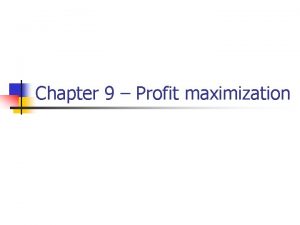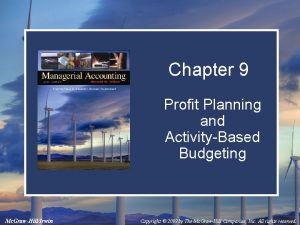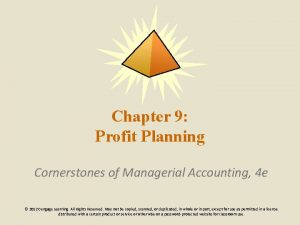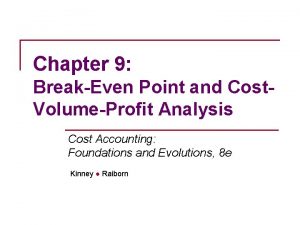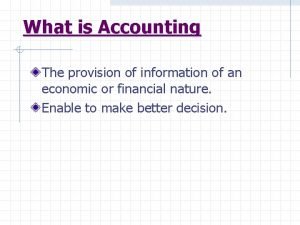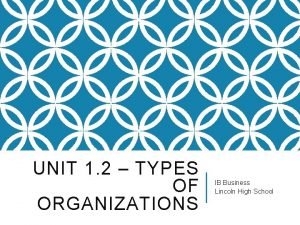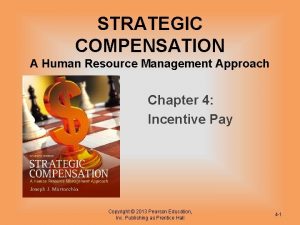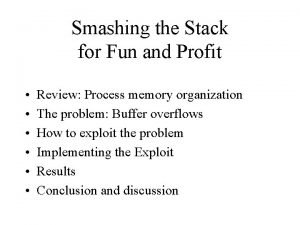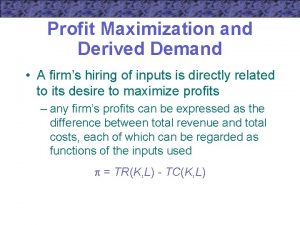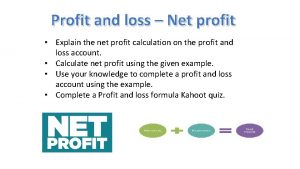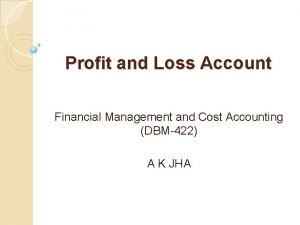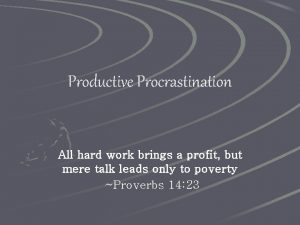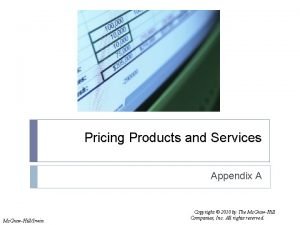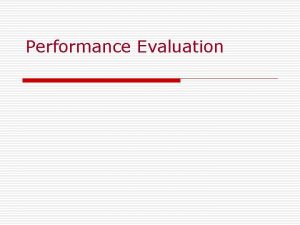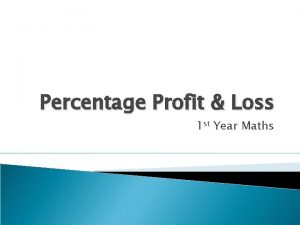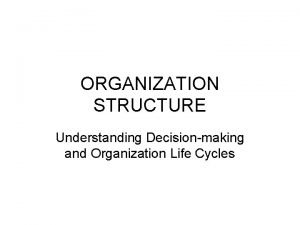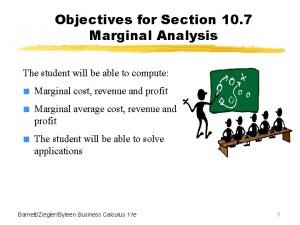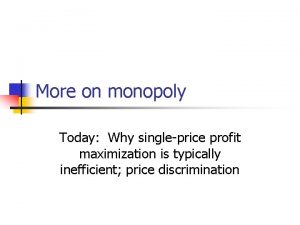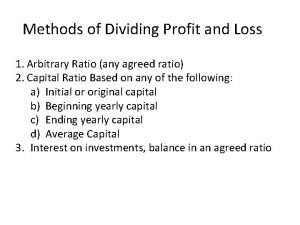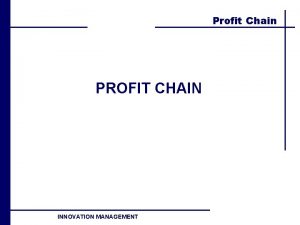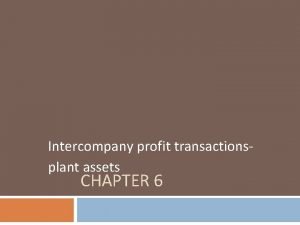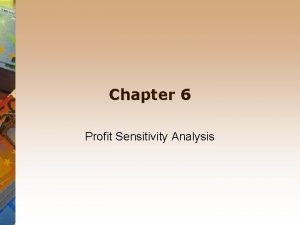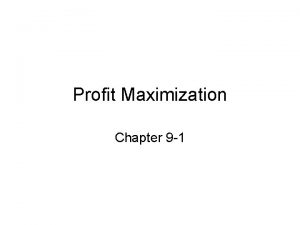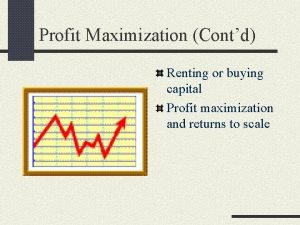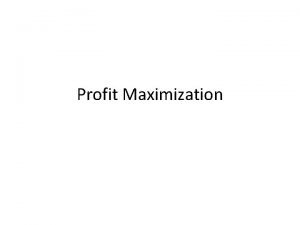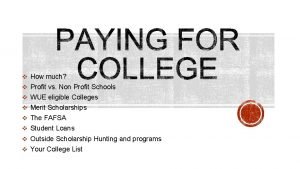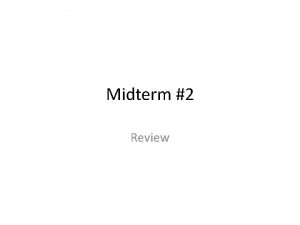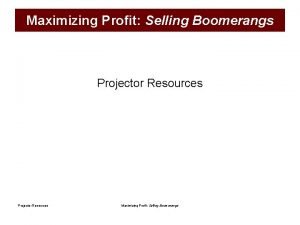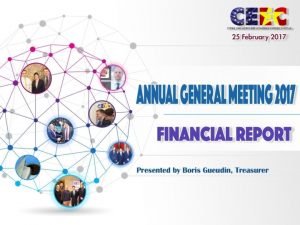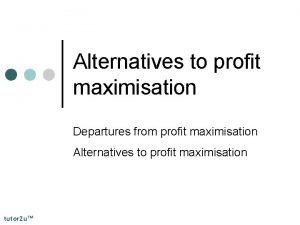PROFIT PLANNING Chapter 07 Chapter 7 Profit Planning
















































- Slides: 48

PROFIT PLANNING Chapter 07 Chapter 7: Profit Planning Power. Point Authors: Susan Coomer Galbreath, Ph. D. , CPA Charles W. Caldwell, D. B. A. , CMA Jon A. Booker, Ph. D. , CPA, CIA Cynthia J. Rooney, Ph. D. , CPA Mc. Graw-Hill/Irwin This chapter focuses on the steps taken by businesses to achieve their planned levels of profits, a process called profit planning. Profit planning is accomplished by preparing numerous budgets, which, when brought together, form an integrated business plan known as a master budget. Copyright © 2013 by The Mc. Graw-Hill Companies, Inc. All rights reserved.

The Basic Framework of Budgeting A budget is a detailed plan for future that is usually expressed in quantitative. 1. The act of preparing a budget is called budgeting. 2. Management tool that communicates management plans throughout the organization allocated recourses, coordinates activates(master budget) A budget is a detailed quantitative plan for acquiring and using financial and other resources over a specified forthcoming time period. The act of preparing a budget is called budgeting. The use of 7 -2 budgets to control an organization’s activities is known as budgetary control.

Planning and Control Planning – involves developing objectives and preparing various budgets to achieve those objectives. Control – involves developing feedback to ensure that the plan is being executed or modified as circumstance change Planning involves developing objectives and preparing various budgets to achieve those objectives. Control involves the steps taken by management to increase the likelihood that the objectives set down at the planning stage are attained and that all parts of the organization are working together toward that goal. To be effective, a good budgeting system must provide for both planning and control. Good planning without effective control is time wasted. 7 -3

Advantages of Budgeting Communicate plans Coordinate activities Define goals and objectives Advantages Think about and plan for the future Means of allocating resources Uncover potential bottlenecks Budgets communicate management’s plans throughout the organization. Budgets force managers to think about and plan for the future. The budgeting process provides a means of allocating resources to those parts of the organization where they can be used most effectively. The budget process can uncover potential bottlenecks before they occur. Budgets coordinate the activities of the entire organization by integrating the plans of its various parts. Budgets define goals and objectives that can serve as benchmarks for evaluating subsequent performance. While our focus in this chapter is on preparing operating budgets for a one-year time frame, longerterm budgets also can be very helpful to organizations from a planning standpoint. 7 -4

Responsibility Accounting Managers should be held responsible for those items - and only those items - that they can actually control to a significant extent. The premise of responsibility accounting is that managers should be held responsible only for those items that they can control to a significant extent. Responsibility accounting systems enable organizations to react quickly to deviations from their plans and to learn from feedback obtained by comparing budgeted goals to actual results. The point is not to penalize individuals for missing 7 -5 targets.

Choosing the Budget Period Operating Budget 2011 2012 Operating budgets ordinarily cover a one-year period corresponding to a company’s fiscal year. Many companies divide their annual budget into four quarters. 2013 2014 A continuous budget is a 12 -month budget that rolls forward one month (or quarter) as the current month (or quarter) is completed. Operating budgets ordinarily cover a one-year period corresponding to a company’s fiscal year. Many companies divide their annual budget into four quarters. In this chapter, we focus on one-year operating budgets. A continuous or perpetual budget is a 12 -month budget that rolls forward one month (or quarter) as the current month (or quarter) is completed. This approach keeps managers focused on the future 7 -6 at least one year ahead.

Self-Imposed Budget A self-imposed budget or participative budget is a budget that is prepared with the full cooperation and participation of managers is a particularly useful approach at all levels. . if Itthe budget will be used to evaluate managerial performance. 7 -7

The Master Budget: An Overview Sales budget Ending inventory budget Direct materials budget Production budget Direct labor budget Selling and administrative budget Manufacturing overhead budget Cash budget Budgeted income statement Budgeted balance sheet 7 -8

ﺷﺮﺡ ﻟﻠﺸﺮﻳﺤﻪ ﺍﻟﺴﺎﺑﻘﻪ The master budget consists of a number of separate but interdependent budgets. We have developed this schematic of the budgeting process to illustrate the interdependency of the various individual budgets. The sales budget shows the expected sales for the budget period expressed in dollars and units. It is usually based on a company’s sales forecast. All other parts of the master budget are dependent on the sales budget. The production budget is prepared after the sales budget. It lists the number of units that must be produced during each budget period to meet sales needs and to provide for the desired ending inventory. The production budget in turn directly influences the direct materials, direct labor, and manufacturing overhead budgets, which in turn enable the preparation of the ending finished goods inventory budget. These budgets are then combined with data from the sales budget and the selling and administrative expense budget to determine the cash budget. The cash budget is a detailed plan showing how cash resources will be acquired and used over a specified time period. All of the operating budgets have an impact on the cash budget. The last step of the process is to prepare a budgeted income statement and a budgeted balance sheet. 7 -9

Budgeting Example Royal Company is preparing budgets for the quarter ending June 30 th. Budgeted sales for the next five months are: April May June July August 20, 000 units 50, 000 units 30, 000 units 25, 000 units 15, 000 units The selling price is $10 per unit. The marketing department of Royal Company prepares the following information that will be used to prepare a budget for the quarter ending June 30 th. 7 -10

The Sales Budget The individual months of April, May, and June are summed to obtain the total budgeted sales in units and dollars for the quarter ended June 30 th Royal sells only one product and that product has a selling price of $10 per unit. To calculate the total sales in dollars for any period, we multiply the budgeted sales in units times the unit selling price. As you can see, Royal forecasts unit sales of 100, 000 and total sales revenue of $1, 000 for the quarter ended June 30 th. Once we complete the sales budget, we can move on to the expected cash collections from sales. 7 -11

Expected Cash Collections • All sales are on account. • Royal’s collection pattern is: 70% collected in the month of sale, 25% collected in the month following sale, 5% uncollectible. • In April, the March 31 st accounts receivable balance of $30, 000 will be collected in full. All sales at Royal are made on account. The company collects 70 percent of the sales revenue in the month of sale, 25 percent in the following month, and estimates that 5 percent of all credit sales will prove uncollectible. At the start of the quarter, Royal had $30, 000 in accounts receivable that were deemed to be fully collectible. Let’s prepare the budget of expected cash collections on sales. 7 -12

Expected Cash Collections The first step in calculating Royal’s cash collections is to insert the March 31 st beginning accounts receivable, $30, 000, into the April column of the cash collections schedule. This balance will be collected in full in April. 7 -13

Expected Cash Collections From the Sales Budget for April. The second step is to calculate the April credit sales that will be collected during each month of the quarter. We will collect another $140, 000 ($200, 000 times 70 percent) in April. In addition, 25% of April projected sales will be collected in May, so $50, 000 of April sales will be collected in May. Finally, 5 percent of April’s sales will prove to be uncollectible. This amounts to $10, 000 ($200, 000 7 -14 times 5 percent).

Expected Cash Collections From the Sales Budget for May. The third step is to calculate the May credit sales that will be collected during each month of the quarter. We will collect $350, 000 ($500, 000 times 70 percent) in the month of May and an additional 25 percent of the $500, 000 will be collected in June. Finally, 5 percent of May’s sales will prove to be uncollectible. The uncollectible amount will be $25, 000 ($500, 000 times 5 percent). 7 -15 Can you complete the final month of June to get the total expected cash collections for the quarter?

The fourth step is to calculate the June credit sales that will be collected during the month of June. We expect to collect $210, 000 ($300, 000 times 70 percent) from June sales in the month of June. The fifth step is to calculate the total for each column in the schedule and the total for the quarter ($905, 000). Now let’s turn our attention to the production budget. Expected Cash Collections

The Production Budget Sales Production Budget d e and et l p Expected m Co Cash Collections The production budget must be adequate to meet budgeted sales and to provide for the desired ending inventory. After we have budgeted our sales and expected cash collection, we must make sure the production budget is adequate to meet the forecasted sales and to provide for the desired ending inventory. We need inventory on hand at the end of the period to minimize the likelihood of an inventory stock 7 -17

The Production Budget • The management at Royal Company wants ending inventory to be equal to 20% of the following month’s budgeted sales in units. • On March 31 st, 4, 000 units were on hand. Let’s prepare the production budget. The management at Royal wants to minimize the probability of a stock-out of inventory items. A policy has been implemented that requires the company to maintain ending inventory of 20 percent of the following month’s budgeted sales. At the beginning of the quarter, Royal had 4, 000 units in inventory. If Royal were a merchandising company it would prepare a merchandise purchases budget instead of a production budget. Let’s get started on the production budget. 7 -18

The Production Budget The first step in preparing the production budget is to insert the budgeted sales in units from the sales budget. 7 -19

The Production Budget March 31 ending inventory. The second step is to calculate the required production in units for April (26, 000 units). Notice, the desired ending inventory in units for April (10, 000 units) and the beginning inventory in 7 -20 units for April (4, 000 units).

The Production Budget The third step is to calculate the required production for May (46, 000 units). Notice, April’s desired ending inventory (10, 000 units) becomes May’s beginning inventory. 7 -21

The Production Budget Assumed ending inventory. The fourth step is to calculate the required production for June (29, 000 units). Notice, we are assuming a desired ending inventory of 5, 000 units. This implies that projected sales in July are 25, 000 units because 20 percent of 25, 000 units is 5, 000 units. The fifth step is to complete the quarter columns. Notice, April’s beginning inventory and June’s ending inventory are carried over to the column. For the quarter, we will need to produce 101, 000 units to meet our sales and 7 -22 inventory goals. Now that we know our required production, let’s look at the direct materials budget.

The Direct Materials Budget • At Royal Company, five pounds of material are required per unit of product. • Management wants materials on hand at the end of each month equal to 10% of the following month’s production. • On March 31, 13, 000 pounds of material are on hand. Material cost is $0. 40 per pound. Let’s prepare the direct materials budget. Each good unit of output requires 5 pounds of direct material. Management does not want to run out of direct materials, so a policy has been established that materials on hand at the end of each month must be equal to 10% of the following month’s production. At the beginning of the month, Royal has 13, 000 pounds of direct material on hand. Each pound of direct material costs $0. 40. Let’s complete the direct materials budget. 7 -23

The Direct Materials Budget From production budget. The first step in preparing the direct materials budget is to insert the required production in units from the production budget. 7 -24

The Direct Materials Budget The second step is to calculate the monthly and quarterly production needs, which in this case are stated in terms of pounds of direct material. 7 -25

The Direct Materials Budget March 31 inventory. 10% of following month’s production needs. Calculate the materials to be purchased in May. The third step is to calculate the materials to be purchased for April (140, 000 pounds). April’s desired ending inventory is equal to 10% of May’s production needs, or 23, 000 pounds. The total number of pounds needed in April is 153, 000 pounds. Finally, we subtract our materials on hand to determine the number of pounds of material that must be purchased. 7 -26 During April, Royal must purchase 140, 000 pounds of direct materials.

The Direct Materials Budget The fourth step is to calculate the materials to be purchased for May (221, 500 pounds). Notice that April’s desired ending inventory becomes May’s beginning inventory. May’s desired ending inventory is 10% of June’s production needs of 145, 000 pounds. 7 -27

The Direct Materials Budget Assumed ending inventory. The fifth step is to calculate the materials to be purchased for June (142, 000 pounds). The desired ending inventory for May becomes the beginning inventory for June. We are assuming a desired ending inventory for June of 11, 500 pounds. April’s beginning inventory and June’s ending 7 -28 inventory carry over to the quarter columns.

Expected Cash Disbursement for Materials • Royal pays $0. 40 per pound for its materials. • One-half of a month’s purchases is paid for in the month of purchase; the other half is paid in the following month. • The March 31 accounts payable balance is $12, 000. Let’s calculate expected cash disbursements. Recall that Royal pays $0. 40 per pound of direct materials. The company pays for onehalf of its purchases in the month of the purchase and one-half in the following month. At the beginning of the quarter, Royal owed creditors $12, 000 for purchases of direct materials. Let’s begin the expected cash disbursement for direct materials schedule. 7 -29

Expected Cash Disbursement for Materials The first step in calculating Royal’s cash disbursements is to insert the beginning accounts payable balance ($12, 000) into the April column of the cash disbursements schedule. This balance will be paid in full in April. 7 -30

Expected Cash Disbursement for Materials Compute the expected cash disbursements for materials for the quarter. 140, 000 lbs. × $0. 40/lb. = $56, 000 The second step is to calculate the April credit purchases that will be paid during each month of the quarter. In April $28, 000 ($56, 000 x 50%) will be paid and $28, 000 will be paid in May. The $56, 000 is derived by multiplying 140, 000 pounds by the $0. 40 per pound purchase price. Now it is time for you to go to work. See if you can complete the expected cash disbursements for materials for the 7 -31 quarter.

Expected Cash Disbursement for Materials The remaining steps include calculating the May and June credit purchases that are paid during each month of the quarter. We also calculate the totals for all columns in the schedule and the total for the quarter ($185, 000). Now let’s move to the direct labor budget. 7 -32

The Direct Labor Budget • At Royal, each unit of product requires 0. 05 hours (3 minutes) of direct labor. • The company has a “no layoff” policy so all employees will be paid for 40 hours of work each week. • For purposes of our illustration assume that Royal has a “no layoff” policy and workers are paid at the rate of $10 per hour regardless of the hours worked. • For the next three months, the direct labor workforce will be paid for a minimum of 1, 500 hours per month. Let’s prepare the direct labor budget. Carefully review the information on the screen. A unique aspect of direct labor at Royal is the no overtime policy. The company agrees to no layoffs of employees if work is slow, but in return, pays its employees straight time at $10 per hour for all hours worked. With the current work force, Royal will have to pay for a minimum of 1, 500 hours of direct labor regardless of the work available. Let’s prepare this budget. 7 -33

The Direct Labor Budget - From production budget. The first step in preparing the direct labor budget is to insert the production in units from the production budget. 7 -34

The Direct Labor Budget - The second step is to compute the direct labor-hours required to meet the production needs. Remember each unit of output requires 0. 05 direct-labor hour. We will require 1, 300 direct labor-hours in April, 2, 300 direct labor-hours in May, and 1, 450 direct labor-hours in June. 7 -35

The Direct Labor Budget - Greater of labor-hours required or labor-hours guaranteed. 7 -36

The Direct Labor Budget - 7 -37

Manufacturing Overhead Budget • At Royal, manufacturing overhead is applied to units of product on the basis of direct labor-hours. • The variable manufacturing overhead rate is $20 per direct labor-hour. • Fixed manufacturing overhead is $50, 000 per month, which includes $20, 000 of noncash costs (primarily depreciation of plant assets). Let’s prepare the manufacturing overhead budget. 7 -38

Manufacturing Overhead Budget Direct Labor Budget. 7 -39

Manufacturing Overhead Budget Total mfg. OH for quarter $251, 000 = $49. 70 per hour * Total labor-hours required 5, 050 * rounded 7 -40

Manufacturing Overhead Budget Depreciation is a noncash charge. 7 -41

Ending Finished Goods Inventory Budget Direct materials budget and information. 7 -42

Ending Finished Goods Inventory Budget Direct labor budget. 7 -43

Ending Finished Goods Inventory Budget Total mfg. OH for quarter $251, 000 = $49. 70 per hour Total labor-hours required 5, 050 7 -44

Ending Finished Goods Inventory Budget Production Budget. 7 -45

Selling and Administrative Expense Budget • At Royal, the selling and administrative expense budget is divided into variable and fixed components. • The variable selling and administrative expenses are $0. 50 per unit sold. • Fixed selling and administrative expenses are $70, 000 per month. • The fixed selling and administrative expenses include $10, 000 in costs – primarily depreciation – that are not cash outflows of the current month. Let’s prepare the company’s selling and administrative expense budget. 7 -46

Selling and Administrative Expense Budget Calculate the selling and administrative cash expenses for the quarter. 7 -47

Selling Administrative Expense Budget 7 -48
 Accounting profit vs economic profit
Accounting profit vs economic profit Economic profit vs accounting profit
Economic profit vs accounting profit Post acquisition profit is which profit
Post acquisition profit is which profit Direct materials budget
Direct materials budget Planning in managerial accounting
Planning in managerial accounting What is profit planning
What is profit planning Cvp analysis formula
Cvp analysis formula Basic assumptions of cvp analysis
Basic assumptions of cvp analysis Strategic planning vs tactical planning
Strategic planning vs tactical planning Goal achievement matrix
Goal achievement matrix Scenario planning workforce planning
Scenario planning workforce planning Inactivism planning
Inactivism planning Aggregate planning is capacity planning for:
Aggregate planning is capacity planning for: Short term planning and long term planning
Short term planning and long term planning Language planning and policy slideshare
Language planning and policy slideshare Aggregate capacity planning
Aggregate capacity planning Aggregate planning is capacity planning for
Aggregate planning is capacity planning for 09 schanlan street, uitenhage
09 schanlan street, uitenhage Contribution and profit
Contribution and profit Returns outwards
Returns outwards Private limited company definition ib business
Private limited company definition ib business Return outwards in profit and loss account
Return outwards in profit and loss account Profit first categories
Profit first categories Gainsharing vs profit sharing
Gainsharing vs profit sharing Advantage of retained profit
Advantage of retained profit Juice parlour business plan
Juice parlour business plan Smashing the stack for fun and profit
Smashing the stack for fun and profit Smashing the stack for fun and profit aleph one
Smashing the stack for fun and profit aleph one Learning outcomes of profit and loss
Learning outcomes of profit and loss Ratio analysis
Ratio analysis Ekonomski profit
Ekonomski profit Monopsony profit maximization
Monopsony profit maximization Calculate profit or loss
Calculate profit or loss Trading profit and loss account format
Trading profit and loss account format Risk bearing theory of profit
Risk bearing theory of profit All hard work leads to profit
All hard work leads to profit Profit-maximizing price formula
Profit-maximizing price formula Price output determination under monopolistic competition
Price output determination under monopolistic competition What oo
What oo Long run profit in perfect competition
Long run profit in perfect competition Calculating percentage increase
Calculating percentage increase Percentage profit
Percentage profit Limitations of profit maximization
Limitations of profit maximization Non profit corporate structure
Non profit corporate structure Gloria misfeldt
Gloria misfeldt Revenue function
Revenue function What is a single price monopoly
What is a single price monopoly Single price monopoly graph
Single price monopoly graph How to compute bonus method
How to compute bonus method
